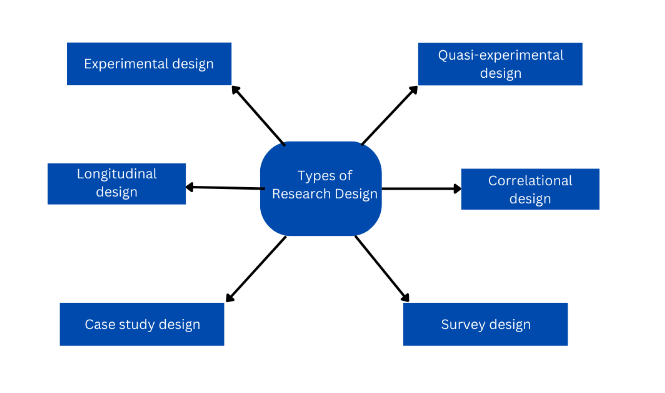Research Design
Research design is the plan or strategy that outlines how a researcher will conduct a study to answer a research question or test a hypothesis. It involves selecting appropriate data collection methods, identifying the sample population, and determining how data will be analyzed.
There are several types of research designs, including:
Experimental design: In this design, the researcher manipulates the independent variable and observes the effect on the dependent variable while controlling for other variables.
Quasi-experimental design: This design is similar to experimental design but lacks random assignment of participants to treatment groups.
Correlational design: This design involves examining the relationship between two or more variables without manipulating them.
Survey design: In this design, the researcher collects data through questionnaires, interviews, or online surveys.
Case study design: This design involves the in-depth examination of a particular case or situation to understand it in its entirety.
Longitudinal design: This design involves collecting data over an extended period to understand changes in the variables of interest over time.
The selection of research design depends on the research question, the data collection methods, the sample population, and the available resources. A well-designed research study should address potential sources of bias and be transparent in its methods and results.

Control of extraneous variables: A good research design should control for extraneous variables that can influence the outcome of the study. This can be done through randomization, matching, or statistical techniques.
Ethical considerations: The research design should consider ethical issues related to the study, including confidentiality, informed consent, and potential harm to participants.
Clear analysis plan: A good research design should have a clear plan for data analysis that is appropriate for the research question and the data collected. The plan should specify the statistical tests to be used, the level of significance, and any assumptions made.
Replicability: The research design should be replicable, meaning that other researchers should be able to conduct the same study using the same methods and obtain similar results.
Overall, a good research design should be well-planned, transparent, and objective, and should provide valid and reliable results that contribute to the knowledge in the field.
Use of Good Research Design: Qualitative and Quantitative Approach
Good research design is essential for both qualitative and quantitative research approaches. Here’s how a good research design is used in both approaches:
Quantitative Research:
Hypothesis Testing: A good research design is critical to testing hypotheses in quantitative research. The research design must specify the independent and dependent variables, the sample size, the data collection methods, and the statistical analysis plan.
Experimental Control: A good research design ensures experimental control in quantitative research, which involves manipulating the independent variable while holding all other variables constant.
Randomization: A good research design also includes randomization procedures to ensure that participants are assigned to treatment groups in a random and unbiased manner.
Validity: A good research design ensures that the study is valid, meaning that the results accurately measure what they are intended to measure.
Qualitative Research:
Research Question: A good research design is essential to developing research questions that are appropriate for qualitative research. The research design should specify the data collection methods, such as interviews, focus groups, or observation, that will be used to answer the research questions.
Sampling: A good research design also involves developing a sampling strategy that is appropriate for the research question and the research participants. The sampling strategy should ensure that participants are representative of the population being studied.
Data Collection: A good research design also involves ensuring that the data collected are rich and detailed, and allow for in-depth analysis of the research question.